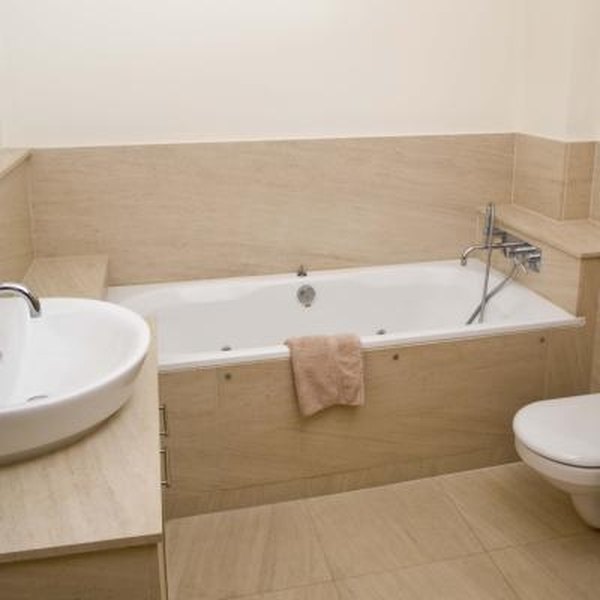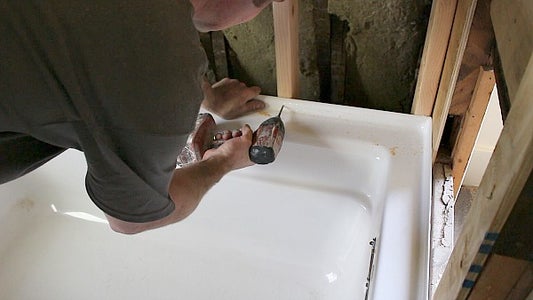Understanding Plumbing Basics is Vital for Bathtub Installation
Understanding Plumbing Basics is Vital for Bathtub Installation
Blog Article
We've noticed this post relating to Tools You Need to Install a New Bathtub below on the web and figured it made sense to discuss it with you here.

Setting up a tub isn't exactly rocket science, but it does need strong plumbing, carpentry, and sometimes, tiling abilities. Replacing an old tub with a new one is also a moderately tough task. If the old bathtub is readily available, the job can relocate immediately; if you need to open up a wall to remove the old tub and also position the new bathtub, the job is much harder. In either case, the task is within a home handyman's skills, although you will require a helper to move out the old tub and embeded in the brand-new one. Make sure you have certified on your own for the job and also fit attempting it. Rather than working with a contractor to take over a halfway-completed job, it is much better to take into consideration employing one before you begin. Opportunities are you might require a professional plumber to make tube connections.
This article will help you install a new bath tub in your shower room if you have currently acquired a brand-new bathtub as well as don't need to change the arrangement of your previous supply of water pipes.
Your tools as well as material list should comprise the following:
Removing Old Touches
If you need to replace old faucets with new ones as a part of your installation, after that the first thing you ought to do is separate the water. After doing so, switch on the taps to drain pipes any type of water continuing to be in the system. The procedure of eliminating the existing taps can be rather problematic due to the limited accessibility that is commonly the situation.
Make use of a container wrench (crowsfoot spanner) or a faucet tool to undo the nut that connects the supply pipelines to the taps. Have a fabric ready for the staying water that will come from the pipes. Once the supply pipelines have actually been removed, use the exact same tool to loosen up the nut that holds the faucets onto the bath/basin. You will certainly need to quit the single faucets from transforming throughout this procedure. When the taps have been removed, the holes in the bath/basin will certainly need to be cleaned of any old securing substance.
Prior to moving on to fit the brand-new faucets, compare the pipe connections on the old faucets to the new taps. If the old taps are longer than the new taps, after that a shank adapter is needed for the brand-new taps to fit.
Fitting New Taps
If the tails of the new taps are plastic, after that you will certainly need a plastic connector to prevent damages to the thread. One end of the adapter fits on the plastic tail of the tap and also the various other end supplies a link to the current supply pipes.
If you need to fit a monobloc, then you will certainly require reducing couplers, which links the 10mm pipeline of the monobloc to the basic 15mm supply pipe.
Next off, place the tap in the mounting hole in the bath/basin making certain that the washers remain in area in between the tap as well as the sink. Safeguard the faucet in position with the supplier given backnut. Once the faucet is safely in position, the supply pipes can be linked to the tails of the taps. The faucets can either be linked by using corrugated copper piping or with regular faucet ports. The previous kind must be attached to the faucet finishes first, tightening up only by hand. The supply pipes can later on be linked to the other end. Tighten up both ends with a spanner after both ends have actually been linked.
Installing the Bathtub
Utilizing both wooden boards under its feet, position the bathtub in the needed setting. The wood boards are useful in evenly spreading the weight of the tub over the location of the boards as opposed to concentrating all the weight onto four small points.
The next goal is to guarantee that the bath tub is leveled all round. This can be attained by examining the level as well as changing the feet on the tub until the spirit level reads degree.
To set up faucets, fit all-time low of the outermost flexible tap connector to the appropriate supply pipeline by making a compression sign up with; then do the same for the other faucet.
Switch on the supply of water and also inspect all joints and brand-new pipework for leaks as well as tighten them if required. Fill up the tub and also check the overflow outlet and the normal outlet for leaks.
Finally, fix the bathroom paneling as explained in the maker's user's manual. Tiling and securing around the bathtub should wait up until the bath tub has actually been used at least once as this will certainly resolve it right into its last placement.
Preparing for the Setup
To start with, the supporting frame supplied with the bath must be fitted (if called for) according to the manufacturer's instructions. Next, fit the faucets or mixer to the bath tub. When suitable the tap block, it is very important to make certain that if the faucet includes a plastic washer, it is fitted between the bathroom as well as the faucets. On a plastic bath, it is also reasonable to fit a sustaining plate under the taps unit to stop stress on the bath tub.
Fit the versatile faucet ports to the bottom of both taps making use of 2 nuts as well as olives (sometimes provided with the tub). Fit the plug-hole electrical outlet by smearing mastic filler round the sink electrical outlet hole, and afterwards pass the electrical outlet through the hole in the bathroom. Utilize the nut provided by the manufacturer to fit the plug-hole. Check out the plug-hole outlet for an inlet on the side for the overflow pipe.
Next, fit the end of the flexible overflow pipe to the overflow outlet. Afterwards, screw the pipe to the overflow face which ought to be fitted inside the bath. See to it you use all of the provided washing machines.
Attach the catch to the bottom of the waste electrical outlet on the bath tub by winding the string of the waste electrical outlet with silicone mastic or PTFE tape, and screw on the catch to the electrical outlet. Link the bottom of the overflow tube in a comparable manner.The bathroom ought to now prepare to be suited its final placement.
Tiling Around the Bathtub
In the location where the bathroom meets the ceramic tile, it is necessary to seal the accompanies a silicone rubber caulking. This is essential as the installation can relocate enough to break a stiff seal, creating the water to penetrate the wall in between the bathroom and also the tiling, leading to problems with moisture as well as feasible leakages to the ceiling listed below.
You can select from a selection of coloured sealers to assimilate your components and also installations. They are marketed in tubes and also cartridges, and also can securing spaces as much as a width of 3mm (1/8 inch). If you have a larger void to load, you can load it with spins of drenched newspaper or soft rope. Remember to always fill up the bathtub with water prior to securing, to enable the movement experienced when the bathtub is in usage. The sealer can split relatively very early if you do not take into account this movement before sealing.
Alternatively, ceramic coving or quadrant tiles can be utilized to edge the bath or shower tray. Plastic strips of coving, which are easy to use and reduce to size, are likewise easily available on the market. It is advisable to fit the tiles making use of waterproof or water-proof glue and cement.
Bathtub Installation
How Important Is A Bathtub To Your Home?
High-quality baths, showers, and other bathroom updates are necessary when considering a smart investment in your home. It’s a room that you go to every day and one that is constantly being used by guests.The bathroom is one of the top trafficked rooms in a home and also one of the most valuable in terms of home resale.
Install Piping Before Tub
You will be using your existing drain and waste vent system, but pipes required include the hot and cold water supply lines and a pipe leading to a shower head. A mixing valve and shower head are also needed. Air chambers may be required.
Position the Tub
Lower the tub into place so that the continuous flange fits against the wall studs and rests on 1’x4' or 2’x4' supports. Anchor the tub to the enclosure with nails or screws inserted through the flanges into the studs.
NOTE: Remember, bathtubs and shower stalls may require support framing. A bathtub filled with water is extremely heavy, so check building codes and framing support before installing the tub.
Assemble Drain Connections
Assemble the bathtub drain connections by connecting the tub overflow with the tub drain above the trap, not beyond it. The trap will have a compression fitting that screws over the arm of the overflow assembly.
Place a Pipe For the Shower Head
First, locate a brass female threaded winged fitting and attach it to a framing support via a screw or a nail. Then run a pipe up the wall for the shower head. Sweat or solder the other side of the brass fitting to the top of the pipe.
Attaching Hot and Cold Water Lines
Attach your water lines for both hot and cold by sweating these directly into the hot and cold ports of the mixing valve. The mixing valve will be how water enters the tub’s system, not by the pipes themselves.
Install the Spout
Extend a piece of 1/2 inch pipe, or whichever length is specified in the manufacturer’s instructions, for the tub spout. Sweat on a male threaded fitting at the end of the pipe or use a brass nipple of the proper length and a 1/2 inch cap.
NOTE: At this point you should have your rough-in plumbing work inspected before proceeding further.
Check For Leaks
Restore the water pressure and check the drain connection and the supply pipes for any sign of leaking.
estore the Bathroom Wall
Replace the wall with moisture-resistant drywall as a base for your wall covering. Seal the joints between the wall and your new tub with silicone caulk as protection against water seepage.
https://www.berkeys.com/2016/12/02/bathtub-installation-dallas/

I'm very fascinated with A Step-by-Step Guide to Installing a Bathtub and I am assuming you enjoyed our post. Sharing is nice. You never know, you may very well be helping someone out. I praise you for your time. Don't forget to come visit our site back soon.
Get professional leak detection today. Report this page